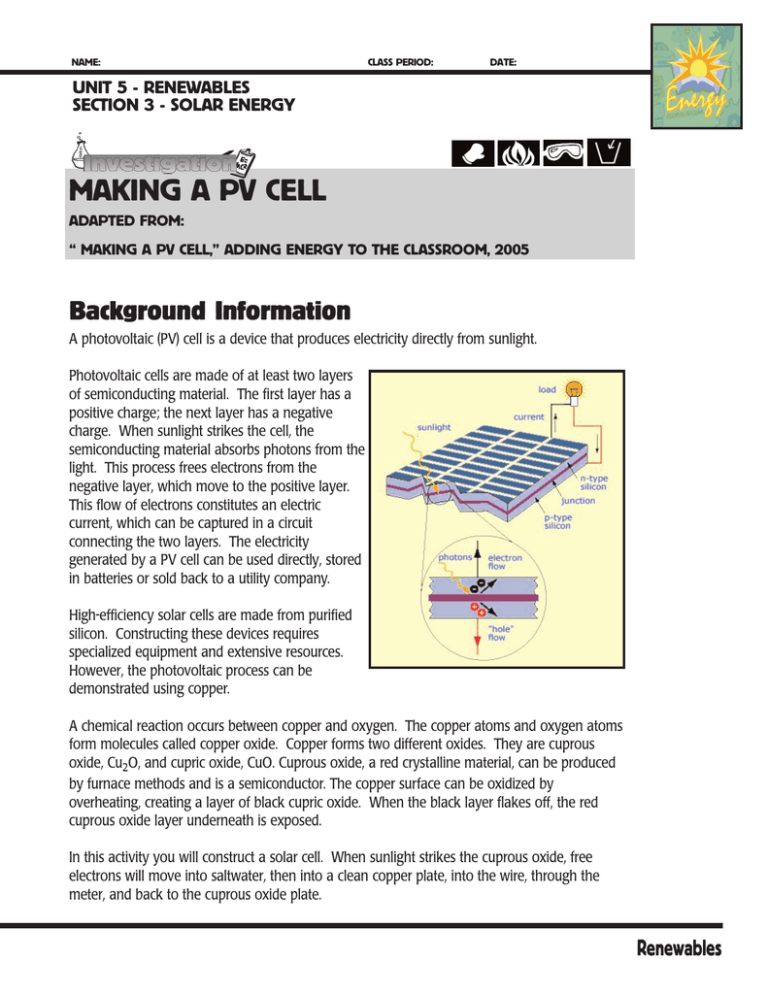making a pv cell - WSU Whatcom County Extension
advertisement

NAME: CLASS PERIOD: DATE: UNIT 5 - RENEWABLES SECTION 3 - SOLAR ENERGY MAKING A PV CELL ADAPTED FROM: “ MAKING A PV CELL,” ADDING ENERGY TO THE CLASSROOM, 2005 Background Information A photovoltaic (PV) cell is a device that produces electricity directly from sunlight. Photovoltaic cells are made of at least two layers of semiconducting material. The first layer has a positive charge; the next layer has a negative charge. When sunlight strikes the cell, the semiconducting material absorbs photons from the light. This process frees electrons from the negative layer, which move to the positive layer. This flow of electrons constitutes an electric current, which can be captured in a circuit connecting the two layers. The electricity generated by a PV cell can be used directly, stored in batteries or sold back to a utility company. High-efficiency solar cells are made from purified silicon. Constructing these devices requires specialized equipment and extensive resources. However, the photovoltaic process can be demonstrated using copper. A chemical reaction occurs between copper and oxygen. The copper atoms and oxygen atoms form molecules called copper oxide. Copper forms two different oxides. They are cuprous oxide, Cu2O, and cupric oxide, CuO. Cuprous oxide, a red crystalline material, can be produced by furnace methods and is a semiconductor. The copper surface can be oxidized by overheating, creating a layer of black cupric oxide. When the black layer flakes off, the red cuprous oxide layer underneath is exposed. In this activity you will construct a solar cell. When sunlight strikes the cuprous oxide, free electrons will move into saltwater, then into a clean copper plate, into the wire, through the meter, and back to the cuprous oxide plate. Renewables 5-3 RENEWABLES NAME: CLASS PERIOD: DATE: MAKING A PV CELL INVESTIGATION CONT. Problem (fill in problem): ______________________________________ ___________________________________________________________ Materials two copper strips 4 cm by 15 cm two alligator clip leads micro-ammeter (0 to 50 microampere scale) or galvanometer electric hot plate shallow, clear plastic container 2 Tbsp. table salt or sodium chloride fine sandpaper goggles gloves 600 ml or larger beaker tray to carry assembly Procedure This lab involves high heat and sharp objects. Wear goggles and gloves at all times and observe all safety precautions. Preparing the copper strips: 1. Wash your hands thoroughly. 2. Wash both copper strips with soap or cleanser to remove all traces of oil or grease. Dirt and oil on the sheet will prevent proper coatings from forming. 3. Continue cleaning the copper strips by using fine sandpaper. Make sure they are very clean. They should be a light pink color. 4. After the copper strips have been cleaned and dried, place one copper strip on the burner and turn the burner to its highest setting. Set the other strip aside to be used later. 5. As the copper starts to heat up, oxidation patterns will begin to form. You will see the oxidation patterns as shades of orange, purple, and red covering the copper. 6. Continue to allow the copper strip to heat for about thirty minutes, until the copper is covered with a thick, black coating. This black coating is cupric oxide. 7. Turn off the burner, but leave the copper strip on the burner and allow it to cool slowly. As it cools, differential shrinkage will cause the cupric oxide to flake off, exposing a coating of cuprous oxide underneath. Clean up the black flakes that collect and discard. Do not try to scrape off any remaining black bits, because this might damage the cuprous oxide coating. Renewables NAME: CLASS PERIOD: 5-3 RENEWABLES DATE: MAKING A PV CELL INVESTIGATION CONT. Assembling the cell: 1. Retrieve the other clean copper strip. Carefully and gently bend both strips so that they will fit inside the clear plastic container. They must not touch each other. The oxide coating that was facing up on the burner should face outside. 2. Dissolve two tablespoons of salt into 500 ml of hot water from the tap. Pour the saltwater into the clear plastic container, leaving two cm of copper strip above the level of the water. 3. Attach the two alligator clip leads, one to the clean copper strip, and one to the oxide-coated strip. Connect the lead from the clean copper strip to the positive terminal of the meter. Connect the lead from the copper oxide-coated strip to the negative terminal of the meter. Testing the Cell: 1. Take the assembled photovoltaic cell outside and face the oxide-coated strip toward the sun. Read the meter. 2. Shade the cell from the sun and read the meter again. Observations 1. What is the reading of the meter in the sun?______________________________________________ ______________________________________________________________________________________ 2. What is the reading of the meter in the shade? ___________________________________________ ______________________________________________________________________________________ Conclusion 1. If the reading of the meter in the shade is not zero, explain why not. ______________________ ______________________________________________________________________________________ ______________________________________________________________________________________ 2. What was the purpose of the saltwater?__________________________________________________ ______________________________________________________________________________________ 3. What are the energy transformations that occurred? _______________________________________ ______________________________________________________________________________________ Renewables 5-3 RENEWABLES NAME: CLASS PERIOD: DATE: MAKING A PV CELL INVESTIGATION CONT. Application 1. How could you double the voltage of your PV cell? _____________________________________ _____________________________________________________________________________________ 2. How could you double the current in your PV cell? ______________________________________ _____________________________________________________________________________________ 3. What are the advantages of using solar technology to generate electricity? ________________ _____________________________________________________________________________________ _____________________________________________________________________________________ Going further 1. Copper oxidizes in air. Why did the copper oxidize faster when heated in a flame? _________ _____________________________________________________________________________________ _____________________________________________________________________________________ Renewables


